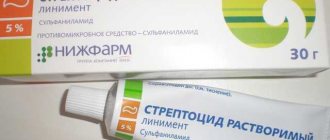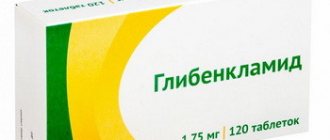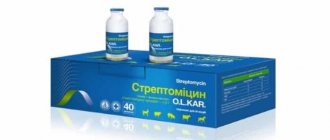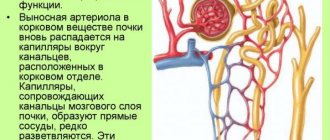Write a review
Reviews: 0
Manufacturers: ICN Tomskkhimpharm (Russia)
Active ingredients
- Sulfanilamide
Disease class
- Otitis externa
- Purulent and unspecified otitis media
- Acute sinusitis
- Acute laryngitis and tracheitis
- Acute upper respiratory tract infection of multiple and unspecified localization
- Syndrome of staphylococcal skin lesions in the form of burn-like blisters
- Impetigo
- Skin abscess, boil and carbuncle
- Phlegmon
- Acute lymphadenitis
- Pilonidal cyst
- Other local infections of the skin and subcutaneous tissue
- Open wound of an unspecified area of the body
- Post-traumatic wound infection, not elsewhere classified
- Acute tonsillitis, unspecified
- Urinary tract infection without established localization
Clinical and pharmacological group
- Not indicated. See instructions
Pharmacological action
- Antimicrobial
Pharmacological group
- Sulfonamides
Pharmacological properties
Streptocide disrupts the creation of so-called “growth factors” in microorganisms - folic and dehydrofolic acids, and other compounds that have PABA (PABA) in their molecule. Due to the similarity of the structures of PABA and Streptocide, sulfanilamide, as a competitive acid antagonist, is included in the metabolic chain of microorganisms and disrupts metabolic processes in it, which leads to a bacteriostatic effect.
Streptocide is a short-acting sulfonamide that exhibits a bacteriostatic effect against streptococci, meningococci, pneumococci, gonococci, Escherichia coli, pathogens of toxoplasmosis and malaria. Does not affect anaerobic microorganisms.
Analogs
Based on the active substance, analogues of streptocide are:
Sulfasalazine Osarcid
Biseptol
Bi-Septin Arghedin
Streptonitol
Groseptol Bactrim
Streptocide is available in tablets, powder and ointments. As an analogue of streptocide ointment, you can use Sunoref ointment, which contains streptocide, sulfadimezin, eucalyptus oil, camphor, norsulfazole, etc. Sunoref is used topically in the treatment of rhinitis.
Contraindications
- Sensitivity to sulfonamides, sulfones or other components of the drug;
- A history of severe toxic-allergic reactions to sulfonamides;
- Inhibition of hematopoiesis in the bone marrow;
- Uncompensated heart failure;
- Diseases of the hematopoietic system;
- Anemia;
- Leukopenia;
- Graves' disease;
- Kidney and liver diseases (nephrosis, nephritis, liver failure, severe renal failure, acute hepatitis);
- Hyperthyroidism;
- Congenital deficiency of glucose-6-phosphate dehydrogenase;
- Azotemia;
- Porphyria.
Interaction with other drugs and other types of interactions
When used simultaneously:
- With nonsteroidal anti-inflammatory drugs, sulfonylurea derivatives, anticoagulants, vitamin K antagonists, the effect of these drugs is enhanced;
- With folic acid, bactericidal antibiotics (including penicillins, cephalosporins) - the effectiveness of sulfonamides is reduced;
- With bactericidal antibiotics, oral contraceptives - the effect of these drugs is reduced;
- With PAS and barbiturates - the activity of sulfonamides increases;
- With erythromycin, lincomycin, tetracycline - antibacterial activity is mutually enhanced, the spectrum of action is expanded;
- Rifampicin, streptomycin, monomycin, kanamycin, gentamicin, oxyquinoline derivatives (nitroxoline) - the antibacterial effect of the drugs does not change;
- With nalidixic acid (nevigramon) - antagonism is sometimes observed;
- With chloramphenicol, nitrofurans - the total effect is reduced;
- With drugs containing PABA esters (novocaine, anesthesin, dicaine), the antibacterial activity of sulfonamides is inactivated;
Sulfonamides are not prescribed simultaneously with hexamethylenetetramine (urotropine), with antidiabetic drugs (sulfonylurea derivatives), with definin, neodicoumarin and other indirect anticoagulants.
Streptocide may enhance the effect of methotrexate due to its displacement from protein binding and/or weakening of its metabolism.
When used simultaneously with other drugs that cause bone marrow suppression, hemolysis, or hepatotoxicity, there is a risk of developing toxic effects.
Concomitant use with Methenamine (urotropine) is not recommended due to the increased risk of developing crystalluria due to an acidic urine reaction.
Phenylbutazone (butadione), salicylates and indomethacin can displace sulfonamides from binding to plasma proteins, thereby increasing their concentration in the blood. When used with para-aminosalicylic acid and barbiturates, the activity of sulfonamides increases; with chloramphenicol - the risk of developing agranulocytosis increases; with preparations containing para-aminobenzoic acid esters (novocaine, anesthesin, dicaine), the antibacterial activity of sulfonamides is inactivated.
Streptocide ointment
Ointment is preferable to liniment because it has a higher concentration of streptocide. The ointment is produced in tubes, each containing 30 grams. The concentration of the substance reaches 10%. Sometimes you can find ointment of 15, 20 or 25 g in jars made of dark glass or plastic.
Method of application of ointment or liniment
Liniment or ointment is applied locally to cover the wound. It is recommended to apply the ointment and liniment in a thin layer without rubbing. It is allowed to apply Streptocide ointment under a gauze bandage.
Continuous use of the product for more than two weeks is not allowed. In some cases, it is allowed to use the product only once a day, on a small area of skin and, under no circumstances, apply it to the face.
Before and after using the drug, wash your hands thoroughly.
Features of application
When treating with the drug, it is necessary to systematically monitor renal function and peripheral blood parameters, blood glucose levels.
During long-term treatment with streptocide, it is necessary to periodically conduct blood tests (biochemical and general blood tests). Prescribing the drug in insufficient doses or early discontinuation of the drug may increase the resistance of microorganisms to sulfonamides.
Sulfonamides should not be used to treat infections caused by group A beta-hemolytic streptococcus, since they do not eradicate it and, as a result, cannot prevent complications such as rheumatism and glomerulonephritis.
The drug should be prescribed with caution to patients with chronic heart failure, liver disease and impaired renal function. Streptocide should be prescribed with caution to patients with severe allergic diseases or bronchial asthma, with blood diseases. If signs of a hypersensitivity reaction appear, the drug should be discontinued.
In case of renal failure, accumulation of sulfonamide and its metabolites in the body is possible, which can lead to the development of a toxic effect.
Sulfonamides, including streptocide, should be used with caution in patients with diabetes mellitus, since sulfonamides can affect blood sugar levels. High doses of sulfonamides have a hypoglycemic effect.
Since sulfonamides are bacteriostatic and not bactericidal drugs, a full course of therapy is necessary to prevent relapse of infection and the development of resistant forms of microorganisms.
Given the similarity of chemical structure, sulfonamides should not be used in people with hypersensitivity to furosemides, thiazide diuretics, carbonic anhydrase inhibitors and sulfonylureas.
Patients need to consume sufficient fluids to prevent crystalluria and the development of urolithiasis.
Elderly people have an increased risk of developing severe adverse reactions from the skin, suppression of hematopoiesis, thrombocytopenic purpura (the latter - especially when combined with thiazide diuretics). Prescribing the drug to patients over 65 years of age should be avoided due to the increased risk of severe adverse reactions.
It is recommended to avoid exposure to direct sunlight and artificial ultraviolet irradiation, given the possibility of developing photosensitivity when using sulfonamides.
During treatment, it is necessary to follow the dosage regimen, apply the recommended dose at intervals of 24 hours, and do not skip doses of the drug. If a dose is missed, do not double the next dose.
If the signs of the disease do not begin to disappear or, conversely, the health condition worsens or adverse events occur, it is necessary to stop using the drug and consult a doctor regarding further use of the drug.
Application of Streptocide
Take orally during or after meals with 150-200 ml. water. A single dose for adults and children over 12 years of age is 600 mg-1.2 g, the daily dose is 3-6 g. The daily dose is divided into 5 doses. Maximum doses for adults: single -2 g, daily -7 g.
A single dose for children aged 3 to 6 years - 300 mg, from 6 to 12 years - 300 mg-600 mg. The frequency of administration for children is 4-6 times a day.
The maximum daily dose for children is 900 mg-2.4 g.
The duration of treatment is determined by the doctor individually, depending on the severity and course of the disease, the localization of the process and the effectiveness of therapy.
Pharmacological authorities
Pharmacodynamics.
Streptocide, like other sulfonamides, disrupts the production of growth factors in microorganisms - folic, dihydrofolic acids, and other compounds that replace para-aminobenzoic acid in their molecule. Due to the fact that its structure is close to the structure of streptocide, the latter, as a competitive antagonist of this acid, is activated in the metabolic organs of microorganisms and disrupts metabolic processes, leading to a bacteriostatic effect. The drug should be administered for a short period of time before sulfonamides.
Streptocide has a bacteriostatic effect against streptococci, meningococci, gonococcus, coliform, toxoplasmosis and malaria. It is important to sacrifice the effectiveness of daily antibiotics. Currently, there are a lot of strains of microorganisms, especially hospital ones, that are resistant to streptocide.
Streptocide activity increases in meadow grass.
Enterococci, Pseudomonas aeruginosa, anaerobes are not sensitive to streptocide.
Pharmacokinetics.
When the internal drug is frozen, it quickly soaks up: the maximum concentration of streptocide in the blood is reached after 1–2 years, after 4 years the drug is detected in the spinal cord region. A decrease in the maximum concentration in the blood by 50% is observed in less than 8 years. Nirki is administered to about 95% of the drug.
Overdose
Side effects may increase.
In case of an overdose, anorexia (lack of appetite), nausea, vomiting, colicky pain, headache, drowsiness, dizziness, and fainting may occur. With long-term use, fever, hematuria, crystalluria, cyanosis, tachycardia, paresthesia, diarrhea, cholestasis, renal failure with anuria, toxic hepatitis, leukopenia and agranulocytosis are possible.
In case of overdose, it is recommended to consult a doctor. Treatment is symptomatic. To provide medical assistance, rinse the stomach with a 2% sodium bicarbonate solution and take a suspension of activated carbon or other enterosorbents. Drinking plenty of fluids, forced diuresis, and hemodialysis are indicated.
Overdose
It is possible to reduce side effects.
In case of overdose, it is possible to experience anorexia (subsistence of appetite), boredom, vomiting, colicky pain, headache, drowsiness, confusion, restlessness.
In cases of severe congestion, possible fever, hematuria, crystalluria, cyanosis, tachycardia, paresthesia, diarrhea, cholestasis, nitric deficiency with anuria, toxic hepatitis, leukopenia, agranulocytosis.
Likuvannya.
In case of overdose, it is recommended to contact a doctor. Before receiving medical assistance, rinse the plug with 2% sodium bicarbonate and take a suspension of active vugill or other enterosorbents. Indications include high blood pressure, forced diuresis, and hemodialysis. Symptomatic rejoicing.
Adverse reactions
From the blood and lymphatic system:
leukopenia, agranulocytosis, aplastic anemia, thrombocytopenia, hypoprothrombinemia, eosinophilia, hemolytic anemia due to glucose-6-phosphate dehydrogenase deficiency.
From the cardiovascular system:
tachycardia, myocarditis.
From the nervous system:
headache; neurological reactions, including aseptic meningitis; ataxia; minor intracranial hypotension, seizures; dizziness; drowsiness/insomnia; feeling tired; depression; peripheral or optic neuropathies; visual impairment; psychosis; depressed state; paresthesia.
From the respiratory system:
pulmonary infiltrates, fibrosing alveolitis.
From the digestive tract:
thirst, dry mouth, dyspepsia, nausea, vomiting, diarrhea, anorexia, pancreatitis, pseudomembranous colitis.
From the digestive system:
increased activity of liver enzymes (AJIT, ACT, alkaline phosphatase), cholestatic hepatitis, hepatonecrosis, hepatomegaly, jaundice, cholestasis.
From the urinary system:
change in urine color (deep yellow-brown color), crystalluria due to acidic urine reaction; possible nephrotoxic reactions: interstitial nephritis, tubular necrosis, renal failure, hematuria, shock kidney with anuria.
From the skin and subcutaneous tissue:
skin hyperemia, skin rashes (including erythematous-squamous, papular), itching, urticaria, allergic dermatitis, photosensitivity, exfoliative dermatitis, erythema nodosum, cyanosis.
Allergic reactions:
allergic reactions, including toxic epidermal necrolysis (Lyell's syndrome), Stevens-Johnson syndrome, systemic lupus erythematosus, serum syndrome, anaphylactic reactions, Quincke's edema, runny nose.
General violations:
drug fever, pain in the right hypochondrium and lower back.
Other:
difficulty breathing, periarteritis nodosa, hypothyroidism, hypoglycemia. In rare cases, hypothyroidism may develop.




